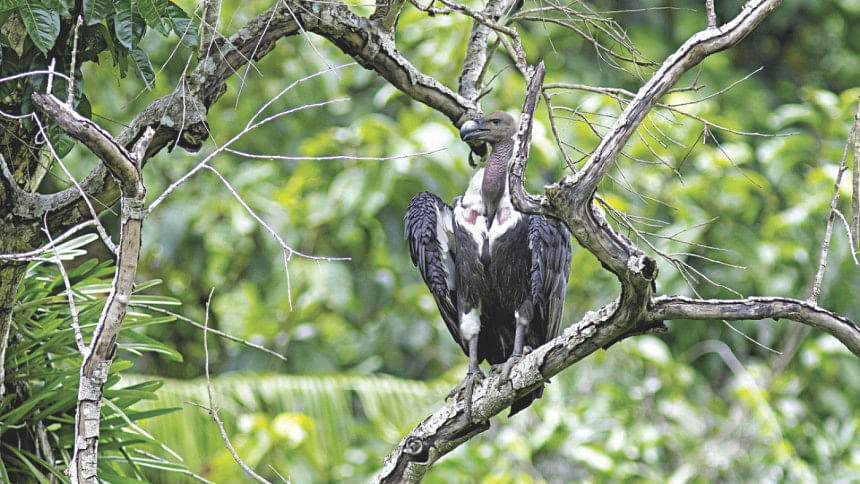Nature Quest: Where vultures come to feast

It was the end of July and the scorching sun was up above at midday. While Dhaka was still reeling from the July 1 tragedy, I decided to escape the hustle and bustle of city life. I responded to one of my colleague's call to visit the vulture conservation project and help him out with a brief research.
The project is currently being conducted by the International Union for Conservation of Nature (IUCN), Bangladesh in collaboration with the Forest Department. Unlike many other conservation projects in Bangladesh, this project is showing good signs.
One of the positive outcomes of the project is the installation of vulture feeding station in Habiganj's Rema-Kalenga Wildlife Sanctuary, where safe and supplementary food is provided to vultures. I had visited the project site in winter but this time the purpose was different -- more exciting than just watching vultures.
We crossed a narrow river when the sun was at its height and humidity pinched our sweaty bodies. We walked past a tea garden with white cotton-like clouds floating across the vast blue sky. Then there were dwarf-hills, above which tall shade trees stood still. As we walked further west, shadows of large wings fell across the short carpet of tea plants. I looked up, enthralled by the sight of the wide wings of a White-rumped vulture.
We continued to walk towards the vulture observation centre where Tarik Kabir and Shimanto Dipu had built a small thatched hut. Sitting in front of the tiny window of the hide, a light breeze touched my face and a strange smell engulfed my mind. I spotted a half-eaten cow provided by the project officials the day before and the vultures seemed to have a grand party on the carcass. The observatory is on a hilltop and the carcass is about 50 metres from it in a valley of sand, little larger than a tennis court, close to a narrow strip of water.
Thirty minutes of silence and a lone vulture landed near the carcass, looked around carelessly and started to clean up the rotten meat. Perhaps there is nothing in the world sadder than watching a vulture descending on a numb body, but this time I was mesmerised.
I looked though my binoculars, captivated, and took a few snaps. In a few moments, more vultures landed on the sand, fast but steady and majestic. The moment was so captivating that I put down my binoculars, camera and notebook and looked at the descending vultures.
It is fascinating to know that the vultures can digest deadly viruses like rabies or anthrax and clean up an ecosystem so efficiently that after every feast nothing of a carcass exists except for some bones. Turkey vultures have such a strong sense of smell that they have remarkably helped natural gas companies detect gas leaks. The gas contains the same chemical found in a dead animal, which attracts the vultures to the leak.
Unfortunately, we have lost 99 percent of our vultures over the last 25 years. Extensive research has identified the cause of the decline to be "diclofenac" -- a non-steroidal anti-inflammatory drug used in treating livestock. Vultures feeding on the carcasses of animals recently treated with the drug suffer renal failure and eventually die. In order to avoid such unfortunate deaths and boost the declining population, the feeding station in Sylhet has been built.
Team members, Miron, Sakib and I installed three camera traps around the feeding station in order to determine vulture species and their population, disturbance as well as other species scavenging at the station. The automatically generated photos through these cameras (detects motion and triggers) will allow us to understand more about the vultures of Rema-Kalenga Wildlife Sanctuary.
We left the place with new hopes that vultures will not vanish into the memories of our elders and children. They will be seen flocking in plains of Bangladesh.
The writer is a Conservation Biologist, currently working on threatened species conservation and research in Bangladesh and abroad.

 For all latest news, follow The Daily Star's Google News channel.
For all latest news, follow The Daily Star's Google News channel. 



Comments